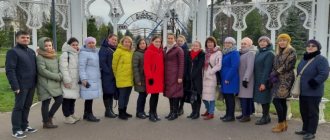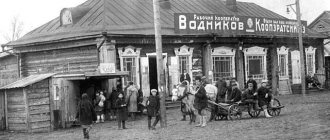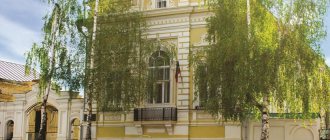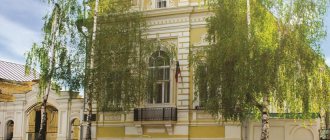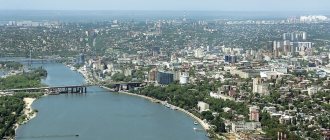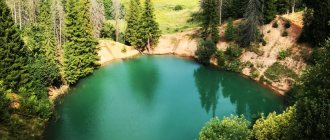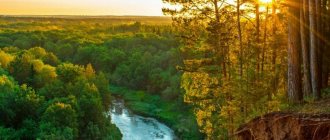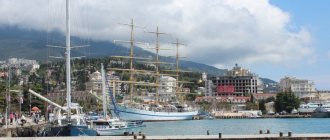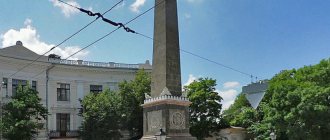The region, now called the Republic of Tatarstan, was developed back in the 8th century BC. Then the first settlements of nomads (Sarmatians) began to appear here. Since the 9th century AD, Volga Bulgaria has existed in this area, inhabited by Turkic peoples. In the 13th century, the Bulgars submitted to the Mongols of Genghis Khan, and after the collapse of the Golden Horde, an independent Kazan kingdom appeared here.
In 1552, Ivan the Terrible captured Kazan and included the kingdom in Muscovy. From that time on, the Kazan kingdom (later the province) was ruled directly from Moscow, without having its own power, like many other autonomies. In 1920, by decree of V.I. Lenin, this region became known as the Tatar Republic, in 1992 - the Republic of Tatarstan.
A convenient way to travel around Tatarstan is organized excursions from Kazan; more details can be found in this article.
Kazan
According to the official version, the settlement was founded at least a thousand years ago as an outpost on the northern borders of Volga Bulgaria. Like the history of any great city, the history of Kazan is very similar to a myth or an adventure novel. This, of course, does not mean the absence of truth, but the presence of unexpected turning points in his life is sometimes surprising. This is the most basic option where to go in Tatarstan by car.
What makes Kazan special is its incredible ability to seamlessly combine two elements. This amazing city unites modernity and antiquity: Asia and Europe, Orthodox and Muslim faiths. Tatar and Russian cultures do not oppose each other, but are united into a single whole. A special feature of Kazan is its multi-level and diverse architecture. Here, next to each other, the ancient Syuyumbike tower and the modern Pyramid shopping center coexist, and the White Stone Cathedral of the Annunciation is wonderfully combined with the Kul Sharif Mosque. The splendor of the “Naryshkin Baroque”, in which the Cathedral of St. Peter and Paul was erected, is in perfect harmony with the strict classical forms of the main building of Kazan University. What excursions in Tatarstan by car can be arranged in Kazan?
The most noticeable attraction of this place is the Kazan Kremlin, which has experienced turbulent and even dramatic historical events. From the second half of the thirteenth to the first half of the 15th centuries, the Kremlin became the center of the Kazan principality within the Golden Horde. After the fall of the Golden Horde, it turned into the administrative and military center of the Kazan Khanate. Later, when Kazan was captured by the troops of Ivan the Terrible in 1552, it began to play a similar role, only as part of the adjacent Volga region. Since 1708, the Kremlin has been the center of the Kazan province. Subsequently, from 1922 to 1992. The Kremlin continued to serve as the administrative center of the Tatar Autonomous Republic, and, starting in 1992, as the national center of the Republic of Tatarstan, part of the Russian Federation. The Kremlin is the residence of the President of the Republic. Thus, this is the main object where it will be most interesting to visit in Tatarstan.
Bulgarian
Where else can you go in Tatarstan by car to make the trip exciting? Nowadays, the city of Bolgar acts as the administrative center of the Spassky district. It is located on the banks of the great Volga, at a distance of 120 km from Kazan. Bolgar was the economic, political and cultural center of Volga Bulgaria. The governor of the region previously lived there. This city was also a place for minting coins, developing crafts such as metallurgy (non-ferrous and ferrous), metalworking, ceramics, jewelry, leather goods, bone and stone carving and many others.
The State Historical and Architectural Museum-Reserve "Bolgar" is one of the few of its kind among the historical and architectural complexes of the Volga Tatars. Today you can see restored archaeological monuments and above-ground buildings belonging to the era of the Golden Horde and the Bulgarian civilization. It is there that you can feel the atmosphere of the eastern medieval city and visit many museum exhibits and places of tourist infrastructure. In 2014, the historical and architectural complex of Bolgara was added to the UNESCO World Heritage List. Thus, this is a very interesting object to visit in Tatarstan by car.
Cities of Tatarstan
Kazan
Kazan is, first of all, a magnificent Kremlin that combines two religions (like the whole of Kazan) - the Annunciation Cathedral and the Kul-Sharif Mosque. In the vicinity of the city there is also a Temple of All Religions, which decided to unite all believers - in one building a Jewish synagogue, Orthodox and Catholic churches, a Muslim mosque, a Chinese pagoda, a Buddhist temple and other characteristic religious buildings are combined.
Chistopol
How to get there from Kazan: by bus Kazan-Chistopol from the Central bus station. Travel time is 2.5-3 hours. You can get to Chistopol by traveling by boat along the Kama.
A small merchant town on the banks of the Kama is the geographical center of Tatarstan. Chistopol has preserved the atmosphere of the district merchant towns. During the Great Patriotic War, it became a shelter for more than 200 members of the Union of Soviet Writers. Nobel Prize winner Boris Pasternak began writing the novel Doctor Zhivago here.
In 2014, the Chistopol State Historical, Architectural and Literary Museum-Reserve was created here.
What to see:
- Melnikov's House, where an art salon and a children's library are located.
- In the old mansion that belonged to the merchant A.A. Poduruev, there is an exhibition of the Museum of the county town, the pearl of which is considered to be 2 wooden bicycles, invented by a local craftsman.
- Memorial Museum of Boris Pasternak, who wrote here during the years of evacuation.
- St. Nicholas Cathedral, built with the money of the Polyakov merchants by the architect Pyatnitsky in 1838.
- Skaryatinsky Garden, which was founded in 1867 with funds from local merchants.
- Not far from Chistopol, the remains of the Golden Horde city of Dzhuketau (X-XV centuries) have been preserved.
Naberezhnye Chelny
Directly opposite Elabuga is the city where the plant that produces KAMAZ trucks is located, the Nizhnekamsk reservoir and many other interesting places.
Elabuga
Elabuga is a county town where the destinies of many wonderful people are intertwined. Shishkin painted here, Tsvetaeva wrote, and for every famous name there are museums, memorial sites, parks and monuments.
Bulgarian
Near Bolgar there are the remains of an ancient settlement, an archaeological site. Temples, mausoleums, baths, chambers and palaces - all this has come to us in the form of ruins and individual stones.
Tetyushi
Tetyushi is an interesting city in itself with old buildings, but it’s even more interesting to travel next to it. For example, to Dolgaya Polyana - a place with strange energy, from where you can clearly see the Great Bolgar.
Ananyinsky burial ground
Address: Ananyino village (near Yelabuga) Opening hours: 24 hours Cost: free
Not far from Yelabuga, in the vicinity of the village of Ananino, in 1858, by pure chance, one of the most significant archaeological discoveries of Tatarstan, and indeed all of Russia, was made. During the spring flood of the river located next to the village, one of the hills was washed away. As a result, ancient burials, fragments of skeletons and household items appeared. Merchant Ivan Shishkin (father of Ivan Ivanovich Shishkin, the great Russian artist) was the first to realize what had happened, and the discovery of the burial ground is attributed to him. After this, archaeologists immediately came here and began to “open up” the burial ground in an organized manner.
The burial itself was located inside a sand mound, the diameter of which was 200 meters and the height was only 4 meters. As a result of excavations, more than 1,500 objects of everyday life, weapons, cultural objects and skeletons of representatives of the past buried here were found here. At the foot, two graves of noble persons, built in the form of stone boats, were discovered. The boats were filled to capacity with jewelry and weapons. As a result of research on the mound, a new term even appeared in science - “Ananyinskaya culture”, which describes representatives of the Finno-Ugric tribes who lived in these places in the 9th-3rd centuries BC.
The village of Ananyino is almost included in the city limits of Elabuga, so almost every route from the city in this direction passes by the burial ground. Buses run all the way to Yelabuga from Kazan, Izhevsk, Naberezhnye Chelny and Nizhnekamsk. You can also get to this city along the Kama River from Kazan (by speedboat) and Nizhnekamsk (by motor ship).
St. Nicholas Cathedral in Chistopol
St. Nicholas Cathedral, built in 1838, is a real decoration of the city, which is definitely worth a visit if you are traveling to Tatarstan. It is a unique example of architectural classicism, which can be clearly seen in the design of the façade parts.
The author of the temple project was the architect Pavel Pyatnitsky, the fence and gate were designed by Thomas Petondi, and funds for its construction were received from merchants Dmitry and Grigory Polyakov.
In the early 90s, the temple, which was used as a warehouse from 1936 to the 1980s, was returned to the Kazan diocese, which actively began its restoration and today the temple is presented to visitors in almost its original form.
How to get there
Kazan has a large international airport located 26 km south of the city. The capital of Tatarstan has regular air connections with most major cities in Russia, as well as cities in Turkey, Bulgaria, Greece, the UAE, and Thailand. In addition, Kazan is a major railway and transport hub. By car from Moscow you can get here via the M7 motorway.
Public transport in Kazan is represented by one metro line, numerous bus routes, tram and trolleybus lines. The Kazan metro includes only 10 stations. There are five tram routes.
Memorial complex of Gabdulla Tukay
Address: st. Central, 4 (Novy Kyrlay village, Arsky district) Phone: (84366) 5-67-10 Opening hours: from 8:00 to 17:00 (Monday – closed) Cost: 100 rubles – adults, 70 rubles – schoolchildren/students and pensioners, 50 rubles – children (under 5 years of age, free admission)
Gabdulla Tukay is considered the founder of new Tatar poetry and his own poetic school. In the small settlement of Kyrlay, which served as an inexhaustible source of inspiration for the poet, a museum and memorial complex dedicated to Tukai was founded in the 1960s. It is housed in two buildings, next to which there are shady alleys, a flower garden and a small pine park.
In the first building, a two-story wooden house, there is a museum in memory of Gabdulla. The first floor is occupied by an exhibition, from which visitors can learn about the life and creative path of the poet. On the second floor there is an exhibition of paintings dedicated to Tukay. The total number of exhibits is 1,700; the most interesting are the personal belongings of the poet and his relatives (birth certificate, working printing press, pieces of furniture). The second house, the mansion of Sagdi (Gabdulla’s adoptive father), is occupied by an exhibition of rural life in the 19th century. It was here that the poet lived in the village of Kyrlay in 1892-95.
You can get to the complex from Arsk. Trains and buses run regularly to this city from Kazan. From Arsk itself, you should take a minibus to the village of New Kyrlay (route to New Kishet, Shurabash or Shushmabash), in its center there is a museum.
Volzhsko-Kama Nature Reserve
Address: Sadovy village, Zelenodolsk district (and surrounding area) Telephone: (84371) 34720 Opening hours: from 10:00 to 17:00 (ticket office until 16:00, closed on Mondays) Cost: 100 rubles for adults and 50 – for children in the arboretum; 60 and 30 rubles respectively – to the nature museum (excursion cost: 200 rubles – adults, 100 – children)
The Raifa Monastery is part of a large complex - the Volga-Kama Biosphere Reserve. The complex was founded in 1960 with the aim of preserving the unique natural landscapes of the Volga region. In 2005, the reserve received the status of a UNESCO reserve. Now the complex is spread over an area of 10 thousand hectares (the protected area is more than 15 thousand).
The collection of the reserve includes one of the most ancient forests in all of Eastern Europe (individual trees are up to 300 years old), 2038 species of plants, 12 of which are listed in the Red Book of Russia, 2644 species of fauna. An arboretum and a nature museum are available for visiting. In the arboretum, which traces its history back to 1921, you can see a collection of 500 species of flora (they are organized in exhibitions according to parts of the world). The Museum of Nature invites visitors to learn about the flora and fauna of the region; it contains more than 50 stuffed animals in several compositions with scenes of animal behavior.
Not far from the mentioned Raifa Monastery there is a special visitor center where tourists can watch a film about the reserve or take a virtual tour of the territory.
You can get to the reserve from Kazan by bus in the direction of Kulbashi or Bishni. The stop you need is Sadovyi.
Raifa Monastery
Address: Raifa village, Zelenodolsk districtPhone: (84371) 3-47-59, (84371) 3-47-07 Opening hours: from 7:00 to 21:00 every day Cost: free
The largest operating monastery in the Republic of Tatarstan is located 30 kilometers from Kazan. It was erected after Ivan the Terrible captured the capital of Tatarstan. In 1613, monk Philaret built a cell on the shore of Lake Raifa. Gradually, Orthodox pilgrims and monks began to gather around him, and with their joint efforts they built a small chapel. In 1661, the monastery received a gift of a copy of the icon of the Georgian Mother of God, which is now the main asset of the monastery. The year 1689 was marked by a fire that destroyed the wooden buildings of the monastery, and at the same time the complex began to be built in stone. By 1708 a church was built, and by 1717 the construction of stone walls with towers was completed. The Georgian Cathedral was built in 1842, the bell tower in 1903, and the Trinity Cathedral in 1910.
Nowadays there is a shelter for orphans on the territory of the Raifa Monastery, and divine services are held regularly. An interesting feature of the lake near the complex are the “silent” frogs - they do not croak here. According to legend, the monks of the monastery prayed to God to deliver them from the sounds constantly coming from the shores of the lake (there are a lot of frogs here and now), which interfered with the performance of church singing. And to this day, no croaking can be heard near the monastery, and even the frogs brought from other places fall silent.
The monastery is located in the center of a village called Raifa Township (or simply Raifa). From Kazan you can get to the monastery by bus, which goes to Kulbashi or Urazly (the route passes very close to the object). Bus No. 405 goes here from Zelenodolsk.
Lake Kara-Kul
Address: Bolshie Lyzi village, Baltasinsky district Opening hours: 24 hours Cost: free
Lake Kara-Kul in the Baltasinsky district can be called the Tatar Loch Ness. A local legend is associated with the reservoir, according to which a huge snake lives here. Local residents call it “su ugese”, which means “water bull”. Legends and myths have preserved for us stories about unsuccessful hunters and fishermen who disappeared in the lake area. The reason for this was the reluctance of people to make sacrifices to the owner of the lake - the snake.
In general, the name Kara-Kul can be translated as “Black Lake”. Indeed, the waters of the lake are distinguished by their blackish color (in cloudy weather, from certain points under the shade of a dense forest, the lake looks bluish-black). Perhaps this circumstance prompted local residents to think about a monster in the pond. In fact, the black tint to the water is given by the karst rocks dissolved in it, from which the shores are made.
Now Kara-Kul is ennobled. A tourist base and a boat rental point have been built here, and there are bridges along the banks. In summer, tourist rallies and other events are often organized near the lake. Fishermen love Kara-Kul for its natural resources - minnows, silver carp and carp are found here.
You can get to the lake from the villages that are located next to it. These are Bolshie Lyzi, Yarak-Churma, Nizhnyaya Sosna. A little further, 4 kilometers away is the center of the district - Baltasi, which has a bus connection with Kazan.
Brief history of Tatarstan
Tatarstan is a republican political unit of the Russian Federation. The history of state formations in this territory, namely, in the Middle Volga region in the bed of the Volga, Kama, Kazanka rivers, began with the creation of Volga Bulgaria - the state of the ancient Bulgars, who came here from the steppes of the Azov region and assimilated with the local Finno-Ugric and Turkic peoples.
Volga Bulgaria
(9-13 centuries) was a large, economically developed medieval state with trade, military, and cultural relations with the countries of the West and East. Many prosperous cities were built on its territory, the fortifications of some of which have survived to this day. In the 10th century, Bulgaria converted to Islam and developed further along the path of a Muslim state. In the 13th century, after the devastating invasion of Mongol troops, known as the Western Campaign of 1236, Volga Bulgaria ceased to exist, and its lands became part of the Golden Horde as an ulus.
After the collapse of the Golden Horde, an independent feudal state was created on the former Bulgarian lands - the Kazan
Khanate
(15-16 centuries), the territory of which even exceeded the size of Volga Bulgaria. The founder of the new state formation was one of the Golden Horde khans, Ulu-Muhammad. In the Kazan Khanate, continuing the traditions of Bulgaria, agriculture, beekeeping, construction, trade, jewelry making, etc. developed.
Constant hostile relations with the Russian state, their mutual claims, attacks and devastation of territories continued until 1552, when Ivan the Terrible, as a result of a series of military campaigns, a long siege and a powerful assault using gunpowder, managed to take Kazan. The Kazan Khanate ceased to exist and territorially became part of the Russian state, which began to introduce Orthodoxy to the annexed lands. The conquered lands were controlled from Moscow, and the new entity was called the Kazan Kingdom.
, the Kazan province was established in 1708
The territory is huge in size, uniting many voivodeships: Sviyazhsk, Penza, Simbirsk, Astrakhan, Ufa, etc. The first governor was Pyotr Apraksin. The boundaries of the province were constantly changing, but its name remained in force until the October Revolution of 1917.
After the Civil War, as a result of decrees of the Soviet government, the Tatar Autonomous Soviet Socialist Republic was formed, which in the 90s of the 20th century turned into the Republic of Tatarstan.
Kuibyshev Reservoir
In Tatarstan there is a confluence of two great rivers - the Volga and the Kama . After the construction of the Zhigulevskaya hydroelectric power station dam, it was hidden by the waters of the Kuibyshev reservoir.
Its length is more than 500 kilometers, the northern part is located on the territory of Tatarstan. As a result of filling the reservoir, a real man-made sea was formed - the width of the water surface at the mouth of the Kama reaches 44 kilometers.
Sviyazhsk
Where to go in Tatarstan for the weekend? At a distance of 30 kilometers from Kazan, at the mouth of the crowded and fast Sviyaga River, there is a wonderful island-city of Sviyazhsk. There are many cities in Russia that have a simple and at the same time complex history. But only a few of them can boast of the same things as Sviyazhsk. This is a small village that acted as a city before.
Sviyazhsk was founded in 1551 by Ivan the Terrible in just four weeks, so that the created settlement could serve as an outpost for the siege of Kazan. It was the first Orthodox settlement in this region, then - the center of the spread of Christianity. Many tourists visit this charming island.
The uniqueness of the island is the only example of special ancient urban planning and the construction of wooden buildings. This is a great place to go to relax in Tatarstan.
The island-city of Sviyazhsk is included in the tentative list of UNESCO heritage sites. The main attractions of the settlement are the Assumption and St. John the Baptist convents. They are located in the west of the island and are easily visible from the right bank of the Sviyaga River, which is also the location of the Kazan health and sports ski complex. In addition, the historical and architectural composition of the island city of Sviyazhsk includes the following: the Assumption Cathedral (16th century), the Church of Constantine and Helen (16-18 centuries), the Trinity Church of the St. John the Baptist Convent (16th century), Sergius Church (1604), Church of the Mother of God “Joy of all who mourn” (1906).
Surrounded by water, this fabulous island is a magnet for tourists and travelers. A person who once stepped on the holy land of Sviyazhsk, full of unsolved mysteries, will retain memories of this special sublime atmosphere of something indestructible and sacred, which turns this place into a magical land.
To get to Sviyazhsk Island, you should rent a tourist boat or purchase a ticket on one of the high-speed river boats from the port of Kazan (travel time is approximately an hour).
Sheshma River
The name of the river means "spring". The Sheshma flows through the territory of Tatarstan and touches part of the Samara region. This river is a left tributary of the Kama. The source of the Sheshma is located on the Bugulma-Belebeevskaya Upland. The river flows into the Kuibyshev reservoir. And to be more precise - to the Kama Bay. The length of the reservoir is 259 km.
Traveling around Tatarstan? Come to the capital: Sights of Kazan with photos and descriptions.
Sheshma flows through a plain, which is divided by a network of gullies, ravines and valleys. The width of the river is 300 m in the upper reaches, and near the mouth this figure can increase to 2 km. In some places, the banks of the Sheshma are quite steep and precipitous. The largest tributaries of the river are Lesnaya Sheshma and Kuvak.
The river is predominantly fed by snow and underground. Sheshma acts as a transport route of local importance. In addition, the reservoir plays a big role for local farmers. The river is a very important source of water supply, without which farming will be quite problematic.
Dolgaya Polyana
Address: Dolgaya Polyana village, Tetyushsky district Opening hours: 24 hours Cost: free
The Dolgaya Polyana natural park includes the village of the same name on the banks of the Volga in the Tetyushsky Mountains. The family estate of the local Molostov family is also located here. At the beginning of the 20th century, Count Molostov brought to Dolgaya Polyana trees and shrubs unique to the area, which still grow in the area today. Examples of such species include Phrygian cornflower, steppe plum, and Andrzeevsky's carnation. Many species of the park's flora are included in the Red Book. The complex itself became a protected area only in 2000.
In addition, “Dolgaya Polyana” is considered one of the most powerful energy zones in the entire republic. Ufologists and psychics often come here for visits. Anomalous points in the park are two clearings on the way to the Volga bank. They have not been overgrown throughout the history of the complex; interference in mechanical and digital devices is observed here. At the same time, people in the clearings feel extraordinary calm, cases of wound healing and blood pressure stabilization have been noted.
You can go to Dolgaya Polyana directly from Kazan, but you will need your own transport for this. From the capital you need to move towards Buinsk, the total distance is 135 kilometers. At the entrance to Tetyushi you will see an alley of larch trees - this is where you need to turn. In addition, you can go from Tetyushi itself (to which there are buses from Kazan).
List
| Lake Proval |
| National Park "Nizhnyaya Kama" |
| Sheshma River |
| Lake Lesnoe |
| Vyazovskie Mountains |
| Blue Lakes |
| Kuibyshev Reservoir |
| Mount Chatyr-Tau |
| Volzhsko-Kama Nature Reserve |
| Dolgaya Polyana |
| Yuryevskaya Cave |
Sights of Tatarstan
Tatarstan is a republic with a rich history, which began to take shape even BC. and has always been at the center of events in any state. In the region you can find natural monuments, historical buildings created by man and cultural heritage.
Religious buildings of Tatarstan
Tatarstan, whose sights are known throughout the country, offers tourists the following objects to explore:
The Kazan Kremlin is one of the most popular places among tourists and the calling card of the city of Kazan. The historical site and museum-reserve is located in the center of the historical part of the city, at the Kremlin, PO Box 522. It is open daily, some of the buildings can be visited at any time, the other part is open according to a schedule, including a mosque, a temple, and museums. A visit is possible on your own or with a guided tour, which is provided on the territory of the Kremlin. The ticket price depends on the chosen direction. There is a single ticket, the price of which is 700 rubles, with which you can visit all museums at a discount. For an individual visit, the price for adults starts from 250 rubles, for schoolchildren, students and pensioners – 100 rubles.
The Kul-Sharif Mosque is the main mosque of the republic. It is considered one of the largest in Europe and covers an area of more than 10 thousand m2. The mosque, which today is located in the city center, was built between 1996 and 2005. The ancient mosque was destroyed back in 1552 under the leadership of Ivan the Terrible, when the city was taken by storm
Anyone can go inside the mosque, no matter what religion they profess, but they must follow the rules, including closed clothing, a covered head and no shoes. The mosque has a museum, the cost of visiting which for adults is 50 rubles, for pensioners and students - 40 rubles, for schoolchildren - 20 rubles.
The Temple of All Religions is an unusual architectural structure built at the end of the last century. Located in the suburbs of Kazan, in the village of Staroye Arakchino. The author was Ildar Khanov, who, with his personal money, created a temple and spiritual center that unites Orthodox churches, Muslim mosques, a Buddhist temple and a Jewish synagogue, as well as a Chinese pagoda and the Catholic Church. The temple has not yet been completed, but the rebuilt pavilions contain an art gallery, an art school and a concert hall. Various master classes and events are held in other rooms.
Museums of Tatarstan
The Museum of the History of Statehood of Tatarstan is located in the Kazan Kremlin in the historical center of the city. The ticket price depends on the chosen direction: exhibition on the 2nd floor - for adults - 150 rubles, for students, pensioners - 100 rubles, for schoolchildren - 80 rubles. When visiting exhibitions on the 1st floor, the ticket price for any category of citizens is 80 rubles.
The History Museum tells about the formation of the Tatar people, the main historical stages and the traditions of the people. It was opened in 2006 and is divided into 2 parts: a permanent exhibition on the 2nd floor, which highlights the 2000-year history of the Tatar people, from education to modern history. On the 1st floor there are exhibitions that change every 2-3 months, but are related to the history and culture of Tatarstan.
It can be visited from Monday to Sunday from 10 to 19 hours. The museum is a unique building, part of which is located underground. From the outside it seems that the building is small, but it has 6 floors, there are elevators and escalators. The museum displays more than 1,000 exhibits, including those telling about the history of the city, the historical place when the tribes lived.
The entire exhibition is divided into 4 blocks. Admission for adults is 200 rubles, for schoolchildren, students and pensioners – 100 rubles. Island-city Sviyazhsk Museum - located in the city of the same name and includes several museums that are dedicated to the history of the city, the history of the civil war, an archeology museum and art gallery, and a museum dedicated to the artist Gennady Arkhireev.
Located at st. Uspenskaya, 22, p. Sviyazhsk Each museum operates at its own time; opening hours should be clarified by phone or on the official website. The cost of the ticket also depends on the chosen museum, but you can purchase a general ticket, which gives a 20% discount on admission.
Elabuga
This charming shopping center with a thousand-year history, located on the banks of the Kama River, is surrounded by magnificent nature. This is a small regional town where the fates of many wonderful people mixed in a very interesting way. In addition, today it is a modern city, which has become one of the centers of development for the automobile industry and oil companies.
Elabuga arose at the end of the 10th-11th centuries and developed as an urban settlement during the years 1005-1010. Empress Catherine II promulgated a decree in 1780, according to which Elabuga was renamed from the village of Trekhsvyatsky to a district town in the Vyatka province. Elabuga later became a place of lively and active trade, and by the mid-19th century it had become a trading center of the large Kama region. The names of merchants from this city are widely known, especially for donations for the construction of city buildings: Stakheev, Ushakov, Chernov, Girbasov and others.
What to see in Tatarstan by car in this area? The Elabuga land was the last home for the poetess Tsvetaeva. In addition, the name of the famous artist Shishkin is also closely connected with the Lower Kama National Park. It was there that he created his famous paintings - “Ship-Grove”, “Morning in a Pine Forest”. It is in this city that his memorial house-museum is located.
Not too far from Elabuga there is the famous Elabuga mound “Chertovo”, which is the remains of a fortified settlement of the Volga tribes of the first millennium of the New Era. The surviving stone tower is a symbol of the Elabuga settlement. This is a great place to travel to Tatarstan by car.
Historical places
Sheremetev Castle
Location: Yurino villageCoordinates: 56.286814, 46.293889
Construction of the palace and park ensemble began in 1812. It was completed just before the revolution in 1915.
In more than 100 rooms of the castle, Italian furniture was placed, the walls were decorated with works by I.K. Aivazovsky, K.P. Bryullov, D.G. Levitsky. The Sheremetev family was especially proud of its collection of great Western European masters: Rembrandt, Boucher and other artists.
Hard times have not been kind to this place. After the revolution, the castle was looted and the building was largely destroyed. A sanatorium was set up in it. By 1990, the castle was practically destroyed.
After the restoration began, it was possible to restore the appearance of the castle. Expensive materials were used. Every effort is being made to restore the place to its former glory. Every year the Skobelev Readings are held in the palace and park ensemble.
Nolkinsky quarries (Gornyak)
Address: Sernur district, Gornyak villageCoordinates: 56.888562, 49.076571
Lovers of history and speleology will be interested in wandering through the abandoned adits.
The caves have different lengths and sizes; in some of them it is possible to move only by crawling.
In some adits there is evidence of ore mining using fire; you can see huge millstones. It is quite cool in the caves; there is snow in the remote adits. Stalactites and stalagmites add mystery.
This place was not without mysticism. It is alleged that in some adits time flows differently - it slows down. Legend has it that the quarries were guarded by a cave spirit - Kamai, who was appeased with offerings in the form of hare meat. Today, the spirit protecting the miners left this place.
What sights to see in Kazan on your own in 1 day?
With only one day of rest left, it is quite difficult to navigate and choose the most interesting and memorable attractions. So, what to see in Kazan on your own from the TOP memorable places:
Everyone's favorite popular Kazan Kremlin is the calling card of the city. An entire archaeological complex allows tourists to get acquainted with the monuments of the 12th-20th centuries. The residence of the governing elite of the republic is located here. You can visit the territory every day from 9.00 to 17.00. Entrance is 3-4 $. You can book an excursion program or take a walk on your own;
Kazan Kremlin
the noisy and crowded Bauman Street has long been popular with visitors. There are many monuments, monuments and museums located here. After walking along the alley, you should definitely stop by the numerous souvenir shops and shops, sit in quiet cafes and try the local cuisine;
Bauman Street
Connoisseurs of antiquity and religious monuments will appreciate the elegant Kul-Sharif Mosque. It was built in 96 on the site of the destroyed mosque of the Kazan Khanate. Here you can listen to amazing stories of the development of the region, learn the features of the cultural heritage of Kazan. You can come here from 9.00 to 19.00. Free admission;
Kul Sharif Mosque
The snow-white cathedral of the Kazan Kremlin with pale blue domes was erected back in the 16th century. It has been subject to reconstruction and transformation many times. It is here that the relics of High Hierarch Guria and other relics of antiquity are located. You can visit the cathedral any day from 10.00 to 18.00. ticket price is 6-10 $;
Cathedral of the Kazan Kremlin
The famous Temple of All Religions is a creative and vibrant landmark of the city that is definitely worth a visit. People of different nationalities and religions come here. Everyone will be able to find a piece of their culture in the temple. 16 denominations are united on the territory of the building. This is one of the unusual places in Kazan that is worth visiting in winter and summer. Ticket cost is 2-4 $. You can come here on weekdays from 9.00 to 18.00;
Temple of All Religions
The majestic Peter and Paul Cathedral was built in the 18th century. It perfectly conveys all the subtleties of the architecture of that time. The icons of the Mother of God of Iveron and the Mother of God of Smolensk are kept here. Coming here, you can see with your own eyes the relics of Ephraim, the famous metropolitan. Now it is the property of the church. Free admission;
Peter and Paul Cathedral
The huge Syuyumbike tower is located on the territory of the Kremlin. According to legend, the beautiful Queen Syuyumbike, to whom Ivan the Terrible himself was wooing, set the condition that if he built a high tower within a week, the wedding would take place. The king complied with the beauty's whim, but the queen threw herself off her, not wanting to marry someone she didn't love;
Tower Syuyumbike
The very beautiful and exquisite building of the bell tower of the Epiphany Cathedral has always attracted the attention of tourists. It is located on Bauman Street
Inside the building is the Church of John the Baptist. You can come here absolutely free;
Bell tower of the Epiphany Cathedral
The magnificent and majestic Palace of Farmers appeared on the list of the main attractions of the region quite recently. The building is very beautiful, designed with a certain chic and pathos. This is a favorite place for visitors and vacationers for unique photo sessions. Now the building houses the Ministry of Agrarian Policy;
Palace of the Farmers
architectural heritage of the 19th century - Aleksandrovsky Passage. The building was planned as the trading floors of a wealthy businessman, but did not live up to the expectations of expensive rent and soon came into the possession of the city authorities.
Alexandrovsky Passage
These are exactly the attractions where you should definitely visit Kazan with children or as a couple during 1 day of your stay in the city. Beautiful architecture, intriguing stories and epics will delight children and adults.
Minerals
Nature has taken care to hide deposits of mineral and fuel raw materials deep underground. Oil is the most basic and valuable resource. There are more than 130 known deposits, possible deposits - about 3 thousand. The main deposits are Bavlinskoye, Romashkinskoye, Novoelkhovskoye. At these 3 sites, the oil produced is estimated at 800 million tons. According to forecasts, production from all fields is 1 billion tons.
Tataria is rich in unlimited reserves of raw materials, which are widely used for the manufacture of building materials. Success in the economic development of the republic directly depends on production.
Minerals of Tatarstan:
- oil, coal;
- oil shale;
- bitumen;
- copper;
- peat;
- phosphorites.
Raw materials mined in the region increase the authority of Tatarstan as a state. And provided that the riches and attractions of the region are treated with care, many more generations will admire the beauty of the region.
Original monuments of Kazan
Compass Monument - Prime Meridian
The Compass Monument is an intricate and extraordinary representative of modern structures. It is made of granite in the shape of a compass with different sides that symbolize parts of the world. A star is laid out around the compass, all the corners of which lead in the direction of the largest and most important cities on Earth. This compass also has an arrow, and it points to the North Pole.
Monument to the wallet
The Wallet Monument is a very controversial object. No one can still find out exactly for what purpose it was installed and what it symbolizes. Some say that the dial at the monument indicates the “time is money” version, others claim that the monument was dedicated to pickpockets: after all, a wallet full of money is grabbed by a hand that holds it tightly.
The monument to the dragon Zilant was presented to the city in 2005 for its millennium.
Monument to the water carrier
The monument to the water carrier is dedicated to the people of this once difficult profession.
Previously, water was delivered to the city at strictly defined times and in limited quantities. Therefore, the profession of a water carrier was very significant until 1874, when the centralization of water supply appeared.
Monument to the carriage
The monument to Catherine the Second's carriage is an exact replica of the carriage on which the Empress came to Kazan while traveling along the Volga.
Historians claim that, having arrived here, Catherine was pleasantly surprised by a very warm welcome; she was greeted like a real queen, covering the entire road from the ship to the carriage with a beautiful velvet carpet.
Monument to the cat
The monument to the Kazan Cat, erected in 2009, is another story associated with Catherine the Great. It is made in the form of a three-meter tent with a mouse on the roof, and inside, on a stool, lies a fat and contented cat.
The history of the Kazan cat is very interesting: during her visit to the city, the empress noticed that there were no mice in Kazan, and gave orders to transport three dozen Kazan cats to St. Petersburg to catch mice that had bred in the imperial palace itself.
Fauna of the region
Tataria is located between steppes and forests, so it has become home to many species of mammals and birds.
Forests and steppes are rich in the following animal species:
- marmots, jerboas and chipmunks;
- hares, foxes and wolves;
- martens, hedgehogs and stoats;
- waterfowl otters and minks.
In total there are about 400 species of various invertebrates and mammals and 300 species of birds.
In the region you can often see:
- long-eared owls and eagle owls;
- white partridges;
- larks and swifts;
- wood grouse and black grouse;
- woodpeckers
In addition to peaceful inhabitants, predatory and waterfowl species settled within the region.
Predators:
- black vultures, kites and golden eagles;
- steppe eagles and griffon vultures;
- Yuviks and peregrine falcons;
- hawks and buzzards.
The rich forests and steppes of the region provide excellent habitat for a wide variety of birds. At the same time, there is plenty of nutrition for each type.
Waterfowl representatives:
- goose, duck, swan;
- common tern;
- duck, merganser;
- common black-headed gull.
All these representatives are a true decoration of the nature of the region. One cannot fail to note the richness of the underwater world. The river depths are simply teeming with freshwater inhabitants:
- carp, catfish and pike;
- ides, asps and chubs;
- trout and pike perch.
Closer to the coastal zone you can often find bream, ruffe, perch and roach.
Mount Chatyr-Tau
Address: Aznakaevsky district (7 kilometers from Aznakaevo) Opening hours: 24 hours Cost: free
The highest point of the Republic of Tatarstan is 321.7 meters above sea level. On many maps it is marked as a ridge, but in fact the mountain is an outlier that took the form of a ridge as a result of erosion of the surrounding area, and not due to tectonic movements.
The name Chatyr-Tau is translated as “tent-mountain”, and this is logical - the remnant looks like a giant green tent. From the top of the mountain you can see a panorama of the surrounding area, as well as the settlements of neighboring Bashkortostan. In 1972, the territory of the mountain and neighboring lands became a natural monument, and in 1999 - a nature reserve. At the foot of Chatyr-Tau lives a colony of steppe bobaks and the flora of the Red Book of Tatarstan grows. The mountain is very popular among fans of hang gliders and paragliders.
Direct buses run from Kazan to Aznakaevo. From the regional center itself you will have to take a taxi (there is the option of walking or traveling as part of an excursion group).
Yuryevskaya Cave
Address: Tenishevo village, Kamsko-Ustinsky district Opening hours: 24 hours a day Cost: by prior arrangement with the hike organizer
The largest cave in the Volga region and at the same time the only cave open to visitors in Tatarstan, Yuryevskaya, is located in the Bogorodsky Mountains. It is a regional natural monument. The first studies in the cave were carried out in 1953. Since that time, speleologists have been clearing away the rubble in the cave (in 1971 its length increased from 20 to 360 meters, in 2009 - to 507 meters).
The cave consists of a cave-in grotto (entrance), two large halls and three manholes. The first one, the Grotto of Rains, is famous for its red stalagmite half a meter high. The second - Red Grotto - has picturesque streaks on the walls, a well and a steep vertical passage. The third hole is difficult to access and closed to visitors. And in general, the entire cave is not equipped for mass excursions; access here is open only in the format of speleo tours with the appropriate equipment.
The cave is located near the village of Tenishevo, 6 kilometers from Kama Ustye. You can get to the center of the area by bus from Kazan, and from there you can go directly to the cave.
Parks, entertainment and more
Tol Babai Estate
Udmurt Father Frost - Tol Babai - lives in the village. Sharkan, called “Udmurt Switzerland”. Here tourists can plunge into the atmosphere of childhood:
- see the estate of Tol Babai and the home of Obyda (Udmurt Kikimora);
- ride horses, tubing, snowmobiles or ATVs;
- visit the House of Masters;
- watch the New Year's performance.
Baba Yaga's residence
There is a legend that here, on the banks of the Yaga River, a woman lived in the swamps. She cooked decoctions and performed rituals. There were rumors among the locals that she flew on a broomstick and raised chicken legs in the hut. Nobody knew her name, so people began to call her Baba Yaga because of her age and place of residence.
It is better to go to the character’s residence with children. Performances are regularly held here, master classes are organized and ancient Slavic drums are played for tourists.
Votkinsk baths
Votkinsk baths are more than just baths. This is a real center for family recreation and health.
There is everything here: from Russian steam rooms to a Japanese bath, from soap massage to mud baths.
Tips for tourists
When you come on an excursion to Kazan, use these useful tips:
- Buy souvenirs at local markets to save money. The Central Market of Kazan is popular among tourists. Here you can buy all kinds of goods at competitive prices.
- Book your accommodation in advance. On the day of arrival, there may be no vacancies in hotels and hotels.
- Choose closed clothes in discreet colors for walking around the city. Some residents of Kazan are Muslims who react negatively to provocative appearance.
- Forget about dietary nutrition during your trip. Let yourself enjoy the amazing Tatar cuisine, which can be tasted in local restaurants.
Azimov Mosque
Everyone calls this mosque the most majestic and beautiful in Kazan. Hundreds of parishioners and city guests come here every day. The Azimov Mosque was built in 1890. At first it was a wooden building, but later the merchant Azimov ordered the wooden building to be demolished and a stone mosque to be erected instead.
During the years of Soviet power, when anti-religious policies were pursued, many religious buildings, including the Azimov Mosque, were closed. After which the building was renovated, and a cinema was opened in it. The only thing that gave away the religious purpose of this place was the minaret.
Local authorities decided to revive the Azimov Mosque only in 1990. And after 2 years it was opened to believers. Over time, the building was completely restored and today we can see the mosque exactly as it was originally.
